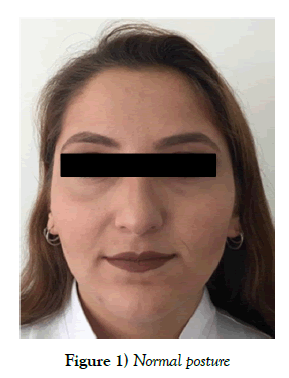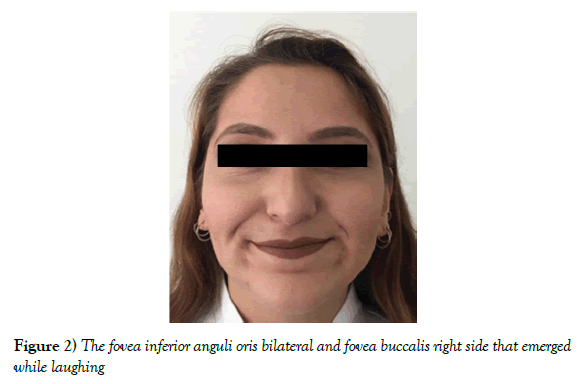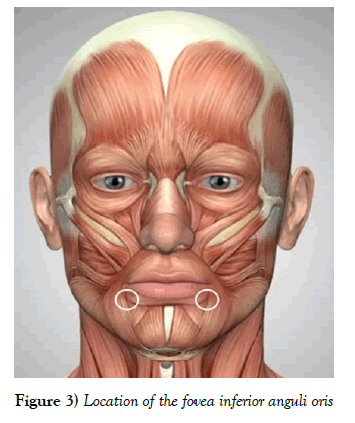Bilateral dimples that are rarely seen in the lower alignment of the mouth corners (Fovea inferior anguli oris)
Received: 09-Nov-2017 Accepted Date: Nov 21, 2017; Published: 27-Nov-2017
Citation: R Kosif, M Diramali, S Sertel Meyvaci. Bilateral dimples that are rarely seen in the lower alignment of the mouth corners (Fovea inferior anguli oris). Int J Anat Var. 2017;10(4): 99-100.
This open-access article is distributed under the terms of the Creative Commons Attribution Non-Commercial License (CC BY-NC) (http://creativecommons.org/licenses/by-nc/4.0/), which permits reuse, distribution and reproduction of the article, provided that the original work is properly cited and the reuse is restricted to noncommercial purposes. For commercial reuse, contact reprints@pulsus.com
Abstract
Sacral Dimples take place in both gender with no specific preponderance, and may state unilaterally or bilaterally and are genetically inherited as a dominant trait. Besides the most seen dimples in our face, buccal and mental; rarely inferior to the level of anguli oris, fovea inferior anguli oris can also be seen. Bilateral dimples have been found on a 20-year-old female medical student which appeared in the alignment of her mouth corners and below 17.49 mm when she was laughing. This dimple was named as fovea inferior anguli oris in our article. Additionally there was fovea buccalis in her right cheek. There was a dimple background in the student’s family. Her grandmother had the same bilateral dimples while the mother had bilateral fovea buccalis. Fovea inferior anguli oris occurs as congenital in the interception points of m. orbicularis oris, m. depressor anguli oris and m. depressor labii inferioris muscles. The frequency of occurrence is unknown.
Keywords
Rarely seen dimple; Fovea inferior anguli oris
Introduction
Dimples are usually seen as a charming characteristic of facial beauty. They take place in both genders with no specific preponderance, may state unilaterally or bilaterally and are genetically inherited as a dominant trait [1]. Anatomically, dimples are regarded to be occasioned by insertion of fascial bands of muscles into dermis or dermal tethering effect of muscles which may be bifid. Dimples which are located on the face look attractive and are described a mark of good fortune and welfare in a great deal of cultures [2,3].
Face dimples appear as marked depressions of varying depth and size. Cheek dimples are frequently and situated at various distance laterally to the angles of the mouth. They may be unilaterally or bilaterally expressed. Their appearance may be enhanced by smiling and they are therefore also called smiling dimples [4]. Fovea Mentalis (chin dimple): The terms cleft chin, chin cleft, dimple chin or chin dimple attribute to a dimple on the chin which is a Y- shaped fissure on the chin with an underlying bony peculiarity. Especially, the chin fissure comes after the fissure in the lower jaw bone that concluded from the incomplete fusion of the left and right halves of the jaw bone, or muscle, during the embryonal and fetal development. For other individuals, it can develop in time, often because one-half of the jaw is longer than the other, causing to facial asymmetry. This is a hereditary trait in humans, where the dominant gene triggers the cleft chin as the recessive genotype presents without a cleft. However, it is also a usual example for variable penetrance with environmental factors or a modifier gene conceivably influencing the phenotypical expression of the actual genotype. Cleft chins are common among people arising from Europe [5]. There is another type of dimple that can be encountered rarely, such as fovea mentalis in the lower part of the mouth. It is observed at the bottom and single or double sided of the mouth corners.
Case Report
A rare dimple was encountered on a 20-year-old female medical student. Bilateral dimples were found 17.49 mm (measured by digital caliper) below the corner of her mouth that were not noticed in normal posture but when she was laughing (Figures 1 and 2). This facial chin dimple appeared in the alignment of her mouth corners and emerged at the interception points of m. orbicularis oris, m. depressor anguli oris and m. depressor labii inferioris muscles (Figure 3). This dimple was named as fovea inferior anguli oris in our article. There was also a fovea buccalis observed slightly on the right side.
The dimple background in her family: It is learned that bilateral fovea buccalis are present on her mother but not on her father and sibling, and also her grandmother has the same bilateral dimples (fovea inferior anguli oris).
The fact is that dimples are essentially genetic imperfections that are derived from shortened facial muscles. Dimples are caused by a deficiency in the subcutaneous connective tissue that develops in course of the embryonic progress. A variation in the pattern of the facial muscle may also lead up dimples. Dimples frequently take place on both, a single dimple on one side is a rare phenomenon [6].
The genetics of dimples is basically rather interesting. They are a dominant trait, which signifies that it only takes one gene to inherit this defect. If neither parent has dimples, their children shouldn’t have them either, unless they experience a spontaneous mutation. If one parent has them, the child has a 25-50% chance of inheriting the gene, since it implies that parent inherited the gene from one or both parents. If both parents have dimples, the child has a 50-100% chance of inheriting the gene, based on how the parents inherited theirs [6]. When a person smiles, the shorter muscle on the face upraises the facial skin. This situation creates a slight depression in the skin, which refers to as dimple [7]. Variations of the zygomaticus major muscle lead cheek dimples to form. The mentalis muscle, which appears around the jawbones, fails to close at the chin thereby leaving a gap. Hence, the appearances of chin dimples or cleft chin deformity.
In this case, a gap congenitally occurs at the interception points of the m. orbicularis oris, m. depressor anguli oris and m. depressor labii inferioris muscles, and when the lower lip is pulled down, a dimple appears while she is laughing. Two different dimples fovea buccalis and fovea inferior anguli oris are seen same female person. There has been limited research on the anatomy of dimples and there is no study showing the frequency of this different kind dimple and multi-dimple according to genus.
Discussion and Conclusion
The fact is that dimples are essentially genetic imperfections that are derived from shortened facial muscles. Dimples are caused by a deficiency in the subcutaneous connective tissue that develops in course of the embryonic progress. A variation in the pattern of the facial muscle may also lead up dimples. Dimples frequently take place on both, a single dimple on one side is a rare phenomenon [6].
The genetics of dimples is basically rather interesting. They are a dominant trait, which signifies that it only takes one gene to inherit this defect. If neither parent has dimples, their children shouldn’t have them either, unless they experience a spontaneous mutation. If one parent has them, the child has a 25-50% chance of inheriting the gene, since it implies that parent inherited the gene from one or both parents. If both parents have dimples, the child has a 50-100% chance of inheriting the gene, based on how the parents inherited theirs [6]. When a person smiles, the shorter muscle on the face upraises the facial skin. This situation creates a slight depression in the skin, which refers to as dimple [7]. Variations of the zygomaticus major muscle lead cheek dimples to form. The mentalis muscle, which appears around the jawbones, fails to close at the chin thereby leaving a gap. Hence, the appearances of chin dimples or cleft chin deformity.
In this case, a gap congenitally occurs at the interception points of the m. orbicularis oris, m. depressor anguli oris and m. depressor labii inferioris muscles, and when the lower lip is pulled down, a dimple appears while she is laughing. Two different dimples fovea buccalis and fovea inferior anguli oris are seen same female person. There has been limited research on the anatomy of dimples and there is no study showing the frequency of this different kind dimple and multi-dimple according to genus.
REFERENCES
- Omotoso GO, Adeniyi PA, Medubi LJ. Prevalence of Facial Dimples amongst South-western Nigerians: A Case Study of Ilorin, Kwara State of Nigeria. Int J Biomed Health Sci. 2010;6:241-4.
- Argamaso RV. Facial dimple: Its formation by a simple technique. Plast Reconstr Surg. 1971;48:40-3.
- Saraf S, Pillutia R. Complication of dimple creation. Indian Dermatol. Online J. 2010;1:42-3.
- Pentzos Daponte A, Vienna A, Brant L, et al. Cheek dimples in Greek children and adolescents. Int J Anthropology. 2004;9:289-95.
- Kosif R. Anatomical Skin Dimples. Innov J Med Health Sci. 2015;5:15-8.
- Jitesh S, Kumar S. Evaluation of Gelasin in South Indian Population. J Pharm Sci Res. 2016;8:828-31.
- Khallaf ANM, Hassan M. Check Dimple Creation - A New Technique: Our Experience of 100 Cases. AAMJ. 2014;12:178-85.









